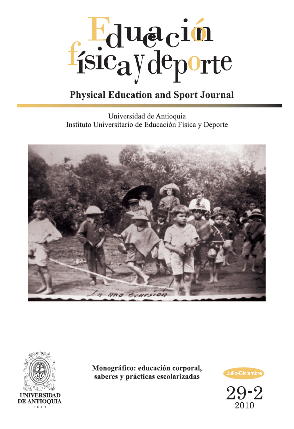Crosscutting, interdisciplinary and learning, a triad that emerges from the spatial
DOI:
https://doi.org/10.17533/udea.efyd.8503Keywords:
Interdisciplinarity, learning, spatial, transversalityAbstract
In its various educational phenomenon has characteristics and nuances throughout history have been framed by the narrowness of the classroom and on the limitations of the infrastructure of educational facilities. But this phenomenon is over the rigidity of the buildings and clouds of curriculum proposals and actions. It is presented as a moment of creation, discovery and expansion not being promoted is enclosed in a constrained world, unwelcoming and much less conspicuous to reach the sublime view of education that emphasizes the growth and development of Human Being In practical terms, preparing man for what should be and do here on this earth and at this time.
Enriched spaces, the staging of activities in unusual places, the confrontation with your fears and insecurities, the remote procedure but not orthodox sense, delivered according to this view a relevant alternative to the educational process and confer humanizing glimpses for purely human phenomenon.
This article is a research associate to research that addressed the ways that student teachers expressed on activities in nature.
Downloads
References
1. Builes, J. (2003). El abordaje de la educación experiencial. Bogotá: Universidad de La Sabana.
2. Castillo, F. (2006). Escuela, motricidad y medio natural. En Revista Ciencias de la Actividad Física, Talca.
3. Castillo, F. (2008). Implementación y desarrollo del tercer eje curricular en NB4 del subsector de Educación Física en los establecimientos educacionales de la comuna de Talca. Universidad Católica del Maule.
4. Castillo, F., & Ried, A. (2006). Motricidad y medio natural. En Revista Pensamiento Educativo, 08, Santiago.
5. Chile, Mineduc. (1998). Decreto Supremo de Educación, 220. Santiago.
6. Chile, Mineduc. (1999). Decreto Supremo de Educación, 232. Santiago.
7. Feitosa, A. (2006). Mudanzas: horizontes desde la motricidad. Universidad del Cauca, Colombia.
8. Fernández, V. (1993). Neurociencias cognitivas y estrategias de educación temprana, Revista Chilena de Nutrición, Santiago.
9. Guillén. (2000). Actividades en la naturaleza. Madrid: INDE.
10. Mella, O. (2003). Metodología cualitativa en ciencias sociales y educación. Santiago: Ediciones Grafic Andes.
11. Retamal, O. (1998). Una educación para reconciliar al hombre con la tierra. Sólo la educación holística hará posible la continuidad de la vida. En Revista Estudios Pedagógicos, 24, 107- 121.
12. Rodríguez, G., Gil, J. & García, E. (1996). Metodología de la investigación cualitativa. Málaga: Ediciones Aljibe.
13. Ruetti, Mustaca & Bentosela. (2008). Memoria emocional: efectos de la corticosterona sobre los recuerdos. En Revista Latinoamericana de Psicología, 40, Buenos Aires.
14. Sergio, M., Toro, S. (2005). La motricidad humana, un corte epistemológico de la Educación Física. Popayán, Colombia: Colección En Acción. Consentido.
15. Taylor & Bogdan. (1987). Introducción a los métodos cualitativos de investigación. Barcelona: Paidós.
16. Trigo, E. (Coord.). (1999). Fundamentos de la motricidad humana. Madrid: Gymnos.
17. Vasilachis, I. (2006). Estrategias de investigación cualitativa. Barcelona: Gedisa.











